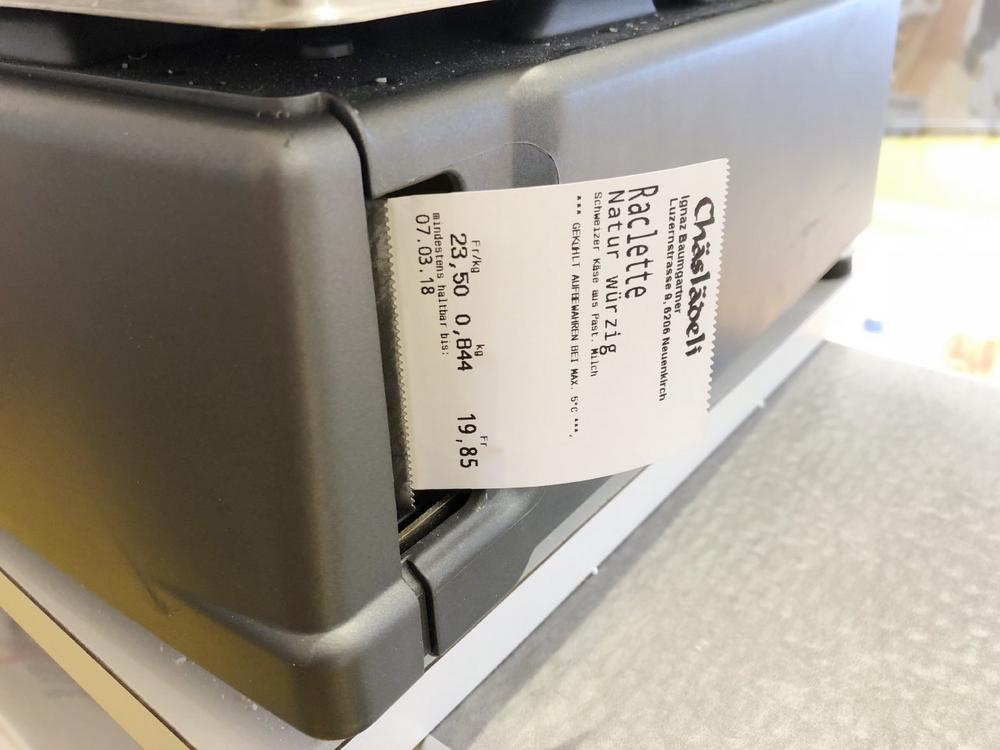This time around, we are focusing on the question of why high-quality individual components should be used and why the use of cheaper alternatives can end up costing much more.
Materials for linerless labels
The following materials are normally required for manufacturing linerless labels:
- Paper, foil or thermal paper
- Silicone
- Adhesive
Linerless labels are sometimes also printed, meaning printing inks are also required.
In this case, printing must be made before the silicone coating is applied so that the ink is between the paper and silicone layers.
High-quality paper and its effect on the silicone
As with many things in life, the manufacturing of linerless rolls demands the use of high-quality materials. This starts with the paper. The paper should have a surface that is as non-porous as possible. When using thermal papers, we recommend using top-coated versions as the surface here is extremely non-porous. This means that the silicone remains on the surface and can cure well. On papers that are too porous, the liquid silicone penetrates the paper and there is a risk of it not curing correctly. On one hand, this can lead to the adhesive coming into contact with the silicone, meaning the adhesive bond is lost. On the other hand, there is also the risk of deposits occurring relatively quickly on the thermal head of the printer, meaning it has to then be stopped and cleaned. In order to achieve a suitably good release, a certain amount of silicone must remain on the paper surface. If some of the silicone penetrates the paper, the amount of silicone used must therefore be increased to compensate for this. As silicone is expensive, it can occur that the savings achieved by using a cheaper paper are already eaten up by the increased amount of silicone applied.
Using cheaper adhesives – a good idea?
Let’s look at another important component, namely the adhesive.
At first glance, significant savings are possible here. In some cases, there are adhesives on offer for linerless applications for €3.50/kg. This is very tempting when you consider the prices of €4.50/kg offered by other suppliers. Anyone buying 10 tonnes of adhesive per year can quickly save €10,000 – a good deal for the linerless manufacturer.
However, are these savings still apparent at the end of the value chain? To answer this question, we have to consider the following aspects: The manufactured rolls are sent to the consumers at supermarkets or logistics centers, for example. When used in the printers here, they must not soil the rollers, cutting blade or print head. Only in this way is a long service life and minimal maintenance of the printers guaranteed.
But is this the case in reality? Let’s assume a cost difference of €1/kg between the two adhesives. With an application weight of 15 g/m² and a label measuring 60×100 mm (0.006 m²), the cost difference is 0.01 cent/label – not exactly a lot. If 100,000 labels are printed, a high-quality adhesive costs €10 more (or €100 more if 1 million labels are printed). If several printers are in use and many labels are printed, the potential savings when using a cheaper adhesive can add up to several thousand euros per year. However, we also have to consider the printer performance: When using artimelt adhesives, more than 1 million labels can be printed and cut without long downtimes on the printer as a result of soiled rollers, blades or print heads. This has been confirmed as part of comprehensive tests made by an independent printer manufacturer. If we assume that only 100,000 labels can be printed and cut before maintenance is needed when using cheaper adhesive, the calculations are as follows:
- Savings when using the cheaper adhesive: €10
- Replacement of the soiled rollers in the printer: €10
- Cost of system downtime (1 hour): €200
Using a cheaper adhesive can thus quickly end up costing more money right from the outset. If a service technician from the weighing instrument manufacturer also has to carry out unplanned maintenance, then things can get very expensive. At an estimated hourly rate of €100 and a half day for the job, €400 in extra costs for the technician would be a fair estimate. And this doesn’t include the further €800 for four hours of system downtime.
In this example, this means that a consumer printing 100,000 labels would end up paying €1,200 in extra costs for using the cheaper adhesive throughout the entire value chain. When extrapolated to 1 million labels, a consumer can thus save €12,000 despite using a more expensive adhesive! These potential savings are much more significant than the higher cost of the superior adhesive! And we haven’t even begun to mention the stress and nerves that were saved – a priceless commodity.
Summary
To summarize:
- High-quality materials are expensive at first glance
- High-quality components often offer improved processing and product performance
- Not only the material costs have to be taken into account, but also the total costs across the entire value chain
- When considering the material costs and processing performance, there are often greater potential savings in using more expensive, high-quality components
If you require more information on finding the right adhesive for your application, our adhesive experts would be happy to help.
artimelt AG
Wassermatte 1
CH6210 Sursee
Telefon: +41 (41) 92605-00
Telefax: +41 (41) 92605-29
http://artimelt.com
Business Operations
Telefon: +41 (41) 92605-32
E-Mail: patrizia.fussen@artimelt.com
